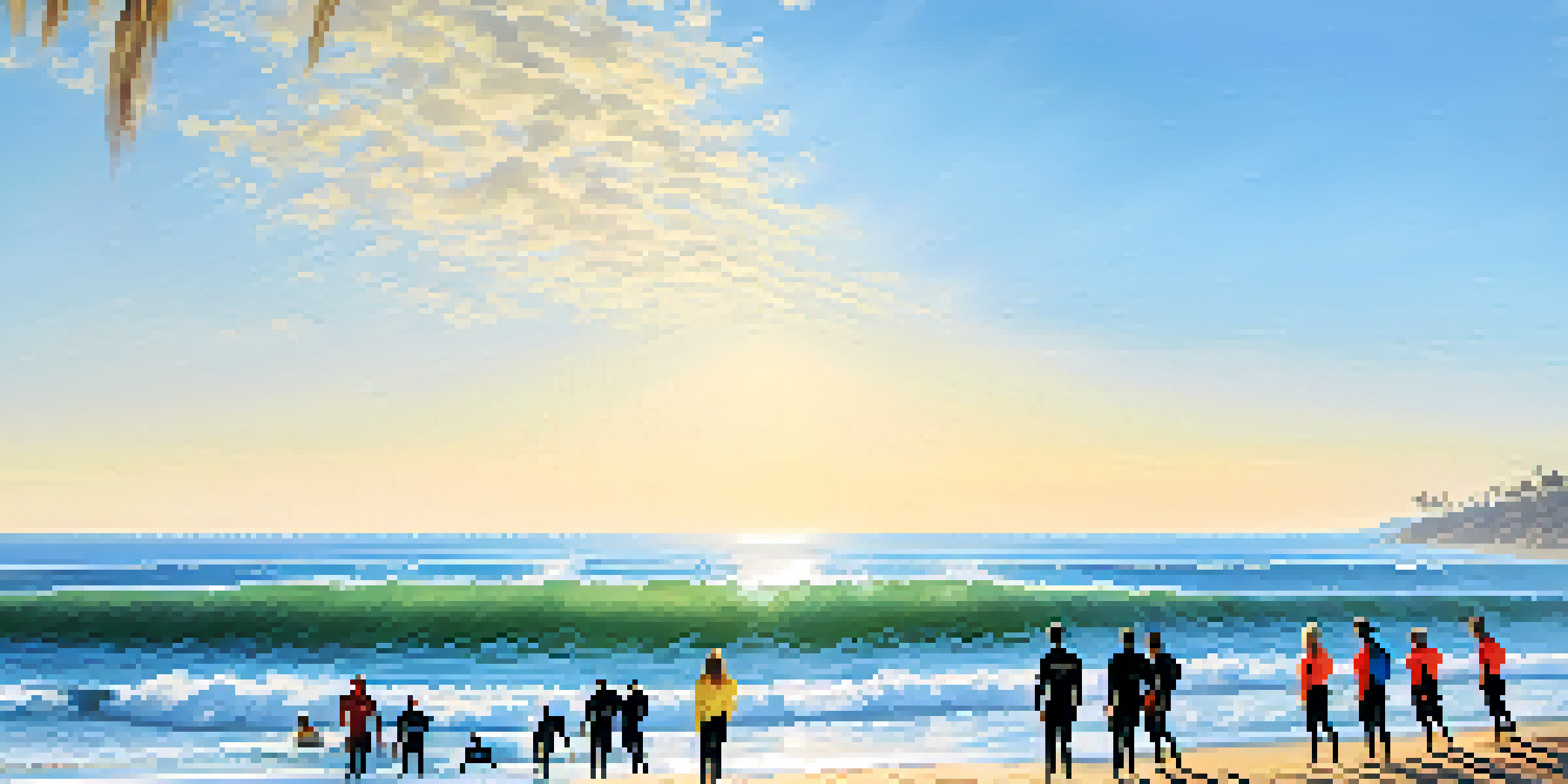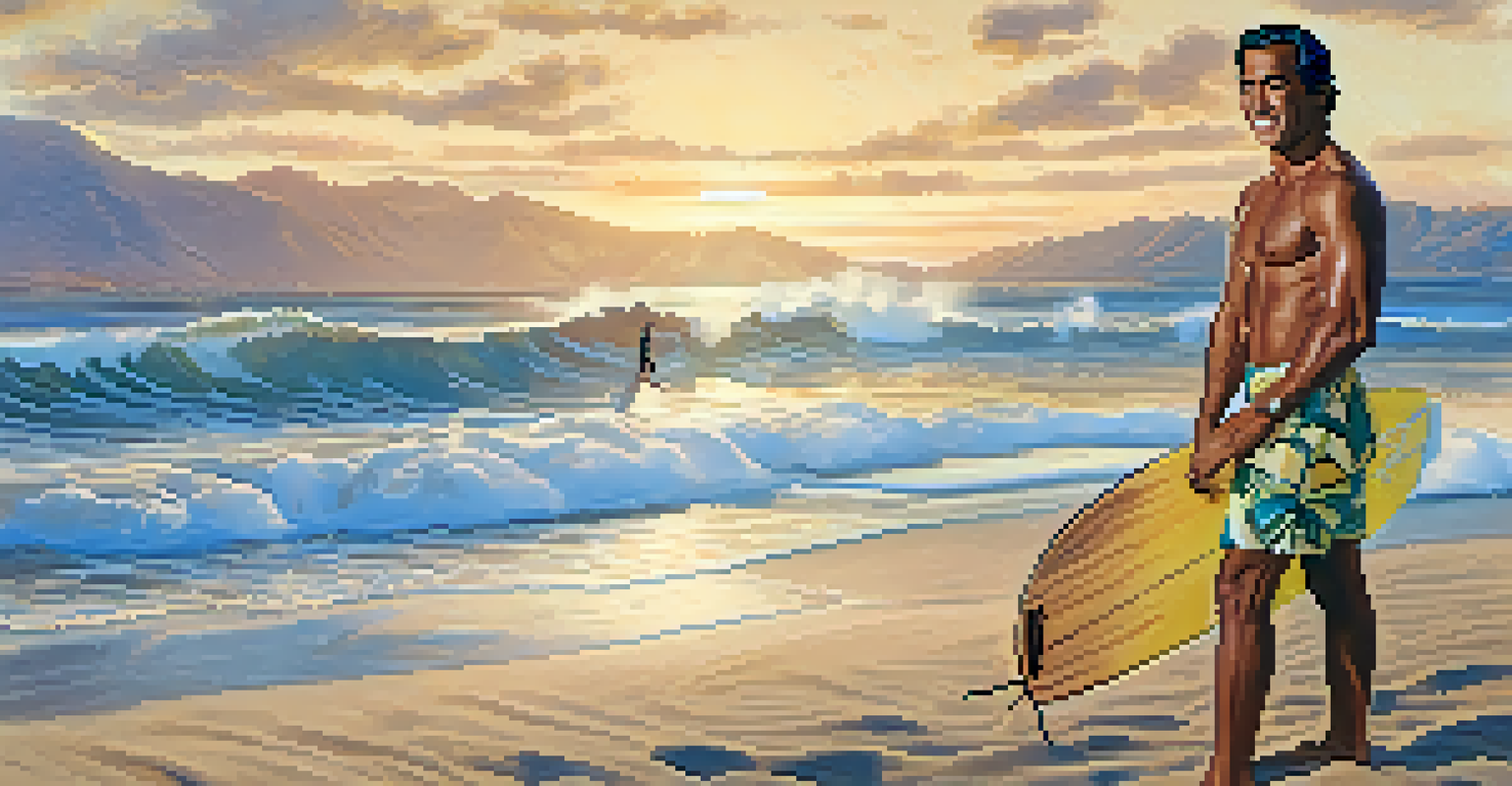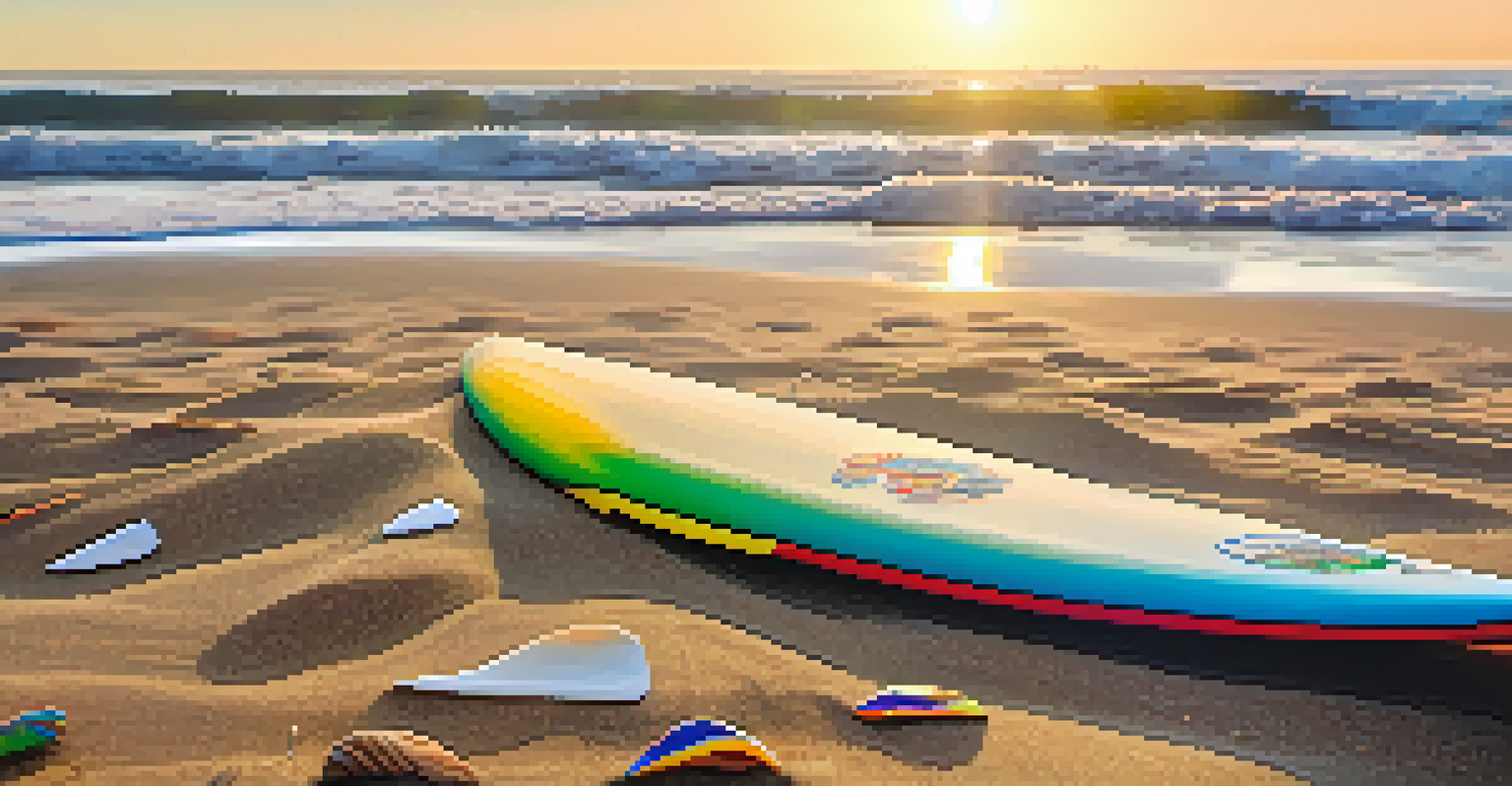Malibu's Legendary Surfers: Pioneers of the Sport

The Surfing Culture of Malibu: A Brief Overview
Malibu is not just a beautiful beach; it’s the birthplace of modern surfing culture. With its stunning coastline and perfect waves, it attracted surfers from all over the world. This idyllic setting served as a playground for those eager to ride the surf, creating a vibrant community that celebrated the sport.
Surfing is not just a sport; it’s a way of life.
In the 1950s and 1960s, Malibu became synonymous with surfing, drawing in pioneers who would shape the sport's future. The iconic point break at Surfrider Beach became a rite of passage for surfers, showcasing their skills and daring feats. It was here that the sport began to transform from a casual pastime into a recognized discipline.
As the surf culture flourished, Malibu became a hub for surfboards, fashion, and music, influencing a generation. Surfing was no longer just a hobby; it was a lifestyle that resonated with freedom and adventure. This laid the groundwork for the legendary surfers who would become icons in their own right.
Duke Kahanamoku: The Father of Modern Surfing
Duke Kahanamoku, a Hawaiian native, is often referred to as the father of modern surfing. He introduced the sport to the mainland U.S. during his travels, inspiring countless surfers to embrace the waves. Duke's charisma and skill not only popularized surfing but also established it as a competitive sport.

His legendary surfing exhibitions in Malibu showcased his unparalleled talent and brought attention to the sport. Duke's influence extended beyond the water; he was an Olympic swimmer and an actor, embodying the spirit of the era. His legacy continues to inspire surfers around the globe, making him a timeless figure in surfing history.
Malibu: Birthplace of Surf Culture
Malibu's stunning waves and vibrant community established it as the epicenter of modern surfing in the 1950s and 1960s.
Kahanamoku’s dedication to promoting surfing helped foster a sense of community among surfers, encouraging them to think of themselves as part of a larger family. His message was clear: surfing was more than just a sport; it was a way of life. This sentiment still resonates within the surfing community today.
Greg Noll: The Big Wave Pioneer
Greg Noll is often hailed as the 'Godfather of Big Wave Surfing,' thanks to his fearless approach to monstrous waves. In the 1960s, he was one of the first surfers to tackle the infamous waves of Waimea Bay, which was no small feat. His daring exploits in Malibu and beyond changed the perception of what surfers could achieve.
The best surfer out there is the one having the most fun.
Noll's signature style and bold personality made him a beloved figure in the surfing community. He was not just about catching waves; he was also a visionary, pushing for more advanced surfboard designs to handle the larger swells. His contributions significantly influenced the sport's evolution.
Beyond his surfing prowess, Greg Noll's charisma and larger-than-life personality added to his legend. He became a symbol of adventure and courage, inspiring generations of surfers to push their limits. His legacy is a reminder that surfing is about more than just riding waves; it’s about embracing challenges head-on.
Linda Benson: A Trailblazer for Women in Surfing
Linda Benson broke barriers in a male-dominated sport, becoming one of the first female surfers to gain recognition in the 1960s. Her talent and determination shone through in competitions, where she often outperformed her male counterparts. Benson's success helped to pave the way for future generations of female surfers.
In Malibu, she became a local legend, inspiring young girls to take to the waves and believe in their abilities. Linda’s story is one of perseverance and empowerment, showcasing how women can excel in any field, including sports. She not only surfed but also worked tirelessly to promote women’s surfing as a legitimate pursuit.
Pioneers Shaped Surfing's Legacy
Legends like Duke Kahanamoku and Greg Noll pushed the boundaries of surfing, inspiring future generations with their daring feats and innovations.
Today, Benson's impact is still felt in the surfing community, where women now compete at the highest levels. Her legacy serves as a powerful reminder of the importance of inclusivity in sports. The waves of Malibu continue to echo her message, encouraging women to ride their own journeys.
The Influence of Surfing Movies on Malibu's Legacy
Surfing films have played a crucial role in shaping Malibu's legendary status, bringing the sport into the mainstream. Movies like 'The Endless Summer' showcased the beauty of Malibu's waves and the thrill of surfing, captivating audiences worldwide. These films not only entertained but also inspired many to take up the sport themselves.
The cinematography in these films highlighted the unique culture surrounding surfing, from the camaraderie among surfers to the stunning landscapes of Malibu. This exposure helped to cultivate a sense of community and belonging within the surfing world. The vibrant images of surfers riding waves became iconic, symbolizing the freedom associated with surf culture.
As surfing gained popularity through films, it also attracted sponsorships and professional competitions, further solidifying Malibu’s place in surf history. The legacy of these films continues to influence new generations of surfers, reminding them of the thrill of catching a perfect wave. Today, Malibu remains a cherished location for both seasoned surfers and aspiring newcomers.
How Malibu Shaped Surfboard Design
Malibu's legendary surfers have significantly influenced surfboard design, leading to innovations that transformed the sport. Early surfboards were heavy and cumbersome, but as surfers like Mickey Munoz experimented with lighter materials, the design evolved. This shift allowed for greater maneuverability and performance on the waves.
The iconic Malibu point break became a testing ground for new surfboard shapes and technologies, inspiring many shapers to create boards tailored to specific conditions. Surfers began to prioritize performance, leading to a golden age of surfboard innovation during the 1960s. These changes not only enhanced the surfing experience but also contributed to a growing market for surfboards.
Surfing Films Boosted Popularity
Movies like 'The Endless Summer' not only showcased Malibu's beauty but also brought surfing into the mainstream, inspiring many to embrace the sport.
Today, the legacy of Malibu’s surfboard design can be seen in the variety of boards available, each tailored to different surfing styles and conditions. This evolution reflects the creativity and passion of the surfing community, who continuously seek to improve their craft. Malibu's influence on surfboard design remains a testament to how a community can innovate and inspire.
The Continuing Legacy of Malibu's Surfers
The impact of Malibu's legendary surfers continues to resonate today, shaping the future of the sport. Their pioneering spirit has inspired countless surfers to embrace the ocean and push their own boundaries. The stories of these icons serve as powerful motivators for both new and experienced surfers alike.
Surfing events in Malibu now honor these legends, celebrating their contributions to the sport and ensuring their stories live on. Competitions like the Malibu Surf Contest highlight the local talent while paying homage to the pioneers who paved the way. This connection to the past fosters a sense of pride within the surfing community.

As surfing evolves with advancements in technology and changes in culture, Malibu remains a symbol of the sport’s rich history. The legendary surfers of this iconic beach have left an indelible mark, reminding us all of the beauty and power of the ocean. Their legacy encourages surfers to ride not just the waves, but also the winds of change in the sport.